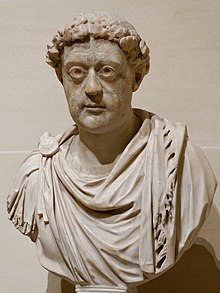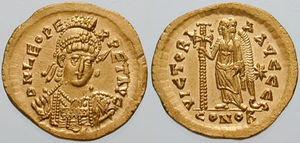Leo I the Thracian
Leo I the Thracian
Jump to navigation
Jump to search
| Leo I | |||||||||
|---|---|---|---|---|---|---|---|---|---|
Augustus of the Eastern Roman Empire | |||||||||
 Imperial portrait of Leo I at the Louvre Museum | |||||||||
| Emperor of the Roman Empire | |||||||||
| Reign | 457–474 | ||||||||
| Coronation | 7 February 457 | ||||||||
| Predecessor | Marcian | ||||||||
| Successor | Leo II | ||||||||
| Co-emperors | Majorian (Western Emperor, 457-461) Libius Severus (Western Emperor, 461-465) Anthemius (Western Emperor, 467-472) Olybrius (Western Emperor, 472) Glycerius (Western Emperor, 473-474) | ||||||||
| Born | 401 | ||||||||
| Died | (474-01-18)18 January 474 (aged 73) | ||||||||
| Wife |
| ||||||||
| Issue | Ariadne, Leontia, unnamed son | ||||||||
| |||||||||
Leo I (Latin: Flavius Valerius Leo Augustus; 401 – 18 January 474) was an Eastern Roman Emperor from 457 to 474. A native of Dacia Aureliana near historic Thrace,[1] he was known as Leo the Thracian (Greek: Λέων Α' ὁ Θρᾷξ Leōn ha ho Thrax).
Ruling the Eastern Empire for nearly 20 years, Leo proved to be a capable ruler. He oversaw many ambitious political and military plans, aimed mostly for the aid of the faltering Western Roman Empire and recovering its former territories. He is notable for being the first Eastern Emperor to legislate in Greek rather than Latin.[2]
He is commemorated as a Saint in the Orthodox Church, with his feast day on January 20.[3][4]
Contents
1 Reign
2 Marriage and children
3 See also
4 References
5 Sources
6 External links
Reign[edit]
This section needs additional citations for verification. (February 2018) (Learn how and when to remove this template message) |

The Roman Empire in 460 during the reign of Leo
He was born Leo Marcellus in Thracia or in Dacia Aureliana province in the year 401 to a Thraco-Roman family.[5] His Dacian origin[6] is mentioned by Candidus Isaurus,[7][8] while John Malalas believes that he was of Bessian stock.[7][9] He served in the Roman army, rising to the rank of comes. Leo was the last of a series of emperors placed on the throne by Aspar, the Alan serving as commander-in-chief of the army, who thought Leo would be an easy puppet ruler. Instead, Leo became more and more independent from Aspar, causing tension that would culminate in the assassination of the latter.
Leo's coronation as emperor on 7 February 457,[10][1] was the first known to involve the Patriarch of Constantinople.[11] Leo I made an alliance with the Isaurians and was thus able to eliminate Aspar. The price of the alliance was the marriage of Leo's daughter to Tarasicodissa, leader of the Isaurians who, as Zeno, became emperor in 474. In 469, Aspar attempted to assassinate Zeno[12] and very nearly succeeded. Finally, in 471, Aspar's son Ardabur was implicated in a plot against Leo and Ardabur was killed by palace eunuchs acting on Leo's orders.[13]
Leo overestimated his capacities and he made some errors that menaced the internal order of the Empire. The Balkans were ravaged by the Ostrogoths, after a disagreement between the Emperor and the young chief Theodoric the Great who had been raised at Leo's court in Constantinople, where he was steeped in Roman government and military tactics. There were also some raids by the Huns. However, these attackers were unable to take Constantinople thanks to the walls, which had been rebuilt and reinforced in the reign of Theodosius II and against which they possessed no suitable siege engines.

Gold solidus of Leo I, struck 462–473 AD at Constantinople.
Leo's reign was also noteworthy for his influence in the Western Roman Empire, marked by his appointment of Anthemius as Western Roman Emperor in 467. He attempted to build on this political achievement with an expedition against the Vandals in 468, which was defeated due to the arrogance of Leo's brother-in-law Basiliscus. This disaster drained the Empire of men and money. The expedition, which cost 130,000 pounds of gold and 700 pounds of silver,[citation needed] consisted of 1,113 ships carrying 100,000 men, but in the end lost 600 ships. After this defeat, Vandals raided Greek coasts until a costly peace agreement was signed between Leo and Genseric.
Leo became very unpopular in his last days as Emperor for abolishing any non-religious celebration or event on Sundays.[citation needed]
Leo died of dysentery at the age of 73 on 18 January 474.
Marriage and children[edit]
Leo and Verina had three children. Their eldest daughter Ariadne was born prior to the death of Marcian (reigned 450 – 457).[14] Ariadne had a younger sister, Leontia. Leontia was first betrothed to Patricius, a son of Aspar, but their engagement was probably annulled when Aspar and another of his sons, Ardabur, were assassinated in 471.[citation needed] Leontia then married Marcian, a son of Emperor Anthemius and Marcia Euphemia. The couple led a failed revolt against Zeno in 478–479. They were exiled to Isauria following their defeat.[15]
An unknown son was born in 463. He died five months following his birth. The only sources about him are a horoscope by Rhetorius and a hagiography of Daniel the Stylite.[15]
The Georgian Chronicle, a 13th-century compilation drawing from earlier sources, reports a marriage of Vakhtang I of Iberia to Princess Helena of Byzantium, identifying her as a daughter of the predecessor of Zeno.[16] This predecessor was probably Leo I, the tale attributing a third daughter to Leo. Cyril Toumanoff identified two children of this marriage: Mithridates of Iberia; and Leo of Iberia. This younger Leo was father of Guaram I of Iberia. The accuracy of the descent is unknown.
See also[edit]
- Church of St. Mary of the Spring (Istanbul)
- Life-giving Spring
- List of Byzantine emperors
References[edit]
^ ab Bury 1958.
^ The Inheritance of Rome, Chris Wickham, Penguin Books Ltd. 2009, ISBN 978-0-670-02098-0 (page 90)
^ Great Synaxaristes (in Greek): Ὁ Ἅγιος Λέων Μακέλλης ὁ Μέγας. 20 Ιανουαρίου. ΜΕΓΑΣ ΣΥΝΑΞΑΡΙΣΤΗΣ.
^ Mother of God of the "Life-Giving Spring". Self-Ruled Antiochian Orthodox Christian Archdiocese of North America. Retrieved: 27 October 2012.
^ Friell 1998, pp. 170, 261.
^ Friell 1998, pp. 170.
^ ab Bury 1958, p. 315.
^ Candidus, F.H.G. IV, p.135
^ John Malalas, XIV, p.369
^ Edward A. Thompson, "Leo I", Encyclopædia Britannica, Vol. 13 (Encyclopædia Britannica, Inc., 1973), p. 959. Bibl. J. B. Bury, History of the Later Roman Empire, vol. i, ch. 10 (1923).
^ Edward Gibbon, The Decline and Fall of the Roman Empire, Volume I, Chap. XXXVI (Chicago: Encyclopædia Britannica, Inc., 1952), p. 582. Bibl. Theophanes, p. 95 [ed. Par.; tom. i p. 170, ed. Bonn].
^ Norwich, John Julius, 'Byzantium: The Early Centuries', pg 167
^ Wace, Henry. Dictionary of Christian Biography and Literature to the End of the Sixth Century A.D., with an Account of the Principal Sects and Heresie
^ Hugh Elton, "Leo I (457–474 A.D.)"
^ ab Prosopography of the Later Roman Empire, vol. 2
^ "Georgian Chronicle", Chapters 13–14. Translation by Robert Bedrosian (1991)
Sources[edit]
Ostrogorsky, George (1956). History of the Byzantine State. Oxford: Basil Blackwell.
Bury, John Bagnell (1958). History of the Later Roman Empire: from the death of Theodosius I to the death of Justinian. Dover books. 1. Dover Publications. ISBN 978-0-486-20398-0.
Friell, Gerard (1998). The Rome That Did Not Fall: The Survival of the East in the Fifth Century. Ancient history. London: Taylor & Francis. ISBN 978-0-415-15403-1.
Meyendorff, John (1989). Imperial unity and Christian divisions: The Church 450-680 A.D. The Church in history. 2. Crestwood, NY: St. Vladimir's Seminary Press. ISBN 978-0-88-141056-3.
Thomas F. Madden (Presenter) (2006). Empire of Gold: A History of the Byzantine Empire; Lecture 2: Justinian and the Reconquest of the West, 457–565 (Audio book). Prince Frederick: Recorded Books. ISBN 978-1-4281-3267-2.- Profile of Leo in The Prosopography of the Later Roman Empire
- Stephen Williams, Gerard Friell, The Rome that Did Not Fall The Survival of the East in the Fifth Century, Routledge Press, 1999, ISBN 0-415-15403-0
External links[edit]
 Media related to Flavius Valerius Leo at Wikimedia Commons
Media related to Flavius Valerius Leo at Wikimedia Commons
Leo I Timeline
Leo I the Thracian Leonid Dynasty Born: 401 Died: 18 January 474 | ||
| Regnal titles | ||
|---|---|---|
| Preceded by Marcian | Eastern Roman Emperor 457–474 | Succeeded by Leo II |
| Political offices | ||
| Preceded by Flavius Constantinus, Flavius Rufus | Consul of the Roman Empire 458 with Imp. Caesar Iulius Maiorianus Augustus | Succeeded by Flavius Ricimerus, Patricius |
| Preceded by Flavius Severinus, Flavius Dagalaiphus | Consul of the Roman Empire 462 with Imp. Caesar Libius Severus Augustus | Succeeded by Flavius Caecina Decius Basilius, Flavius Vivianus |
| Preceded by Flavius Hermenericus, Flavius Basiliscus | Consul of the Roman Empire 466 with Tatianus (Gallia) | Succeeded by Illustrius Pusaeus, Iohannes |
| Preceded by Messius Phoebus Severus, Flavius Iordanes | Consul of the Roman Empire 471 with Caelius Aconius Probianus | Succeeded by Flavius Rufius Postumius Festus, Flavius Marcianus |
| Preceded by Flavius Rufius Postumius Festus, Flavius Marcianus | Consul of the Roman Empire 473 (alone) | Succeeded by Imp. Caesar Flavius Leo Iunior Augustus (alone) |
Categories:
- 401 births
- 474 deaths
- 5th-century Byzantine emperors
- 5th-century Christian saints
- Deaths from dysentery
- Eastern Orthodox royal saints
- House of Leo
- Flavii
- Valerii
- Imperial Roman consuls
- Roman-era Thracians
(window.RLQ=window.RLQ||).push(function()mw.config.set("wgPageParseReport":"limitreport":"cputime":"0.680","walltime":"0.850","ppvisitednodes":"value":4312,"limit":1000000,"ppgeneratednodes":"value":0,"limit":1500000,"postexpandincludesize":"value":79329,"limit":2097152,"templateargumentsize":"value":7159,"limit":2097152,"expansiondepth":"value":16,"limit":40,"expensivefunctioncount":"value":11,"limit":500,"unstrip-depth":"value":0,"limit":20,"unstrip-size":"value":6719,"limit":5000000,"entityaccesscount":"value":1,"limit":400,"timingprofile":["100.00% 673.462 1 -total"," 21.36% 143.818 1 Template:Lang-la"," 18.00% 121.227 1 Template:Infobox_monarch"," 15.52% 104.504 2 Template:Infobox"," 13.30% 89.557 1 Template:Reflist"," 7.71% 51.918 1 Template:Authority_control"," 7.38% 49.712 4 Template:Cite_book"," 6.33% 42.620 3 Template:Citation_needed"," 6.17% 41.565 2 Template:ISBN"," 5.59% 37.660 3 Template:Fix"],"scribunto":"limitreport-timeusage":"value":"0.325","limit":"10.000","limitreport-memusage":"value":12741274,"limit":52428800,"cachereport":"origin":"mw1294","timestamp":"20180903103853","ttl":86400,"transientcontent":true);mw.config.set("wgBackendResponseTime":102,"wgHostname":"mw1240"););

 Clash Royale CLAN TAG
Clash Royale CLAN TAG